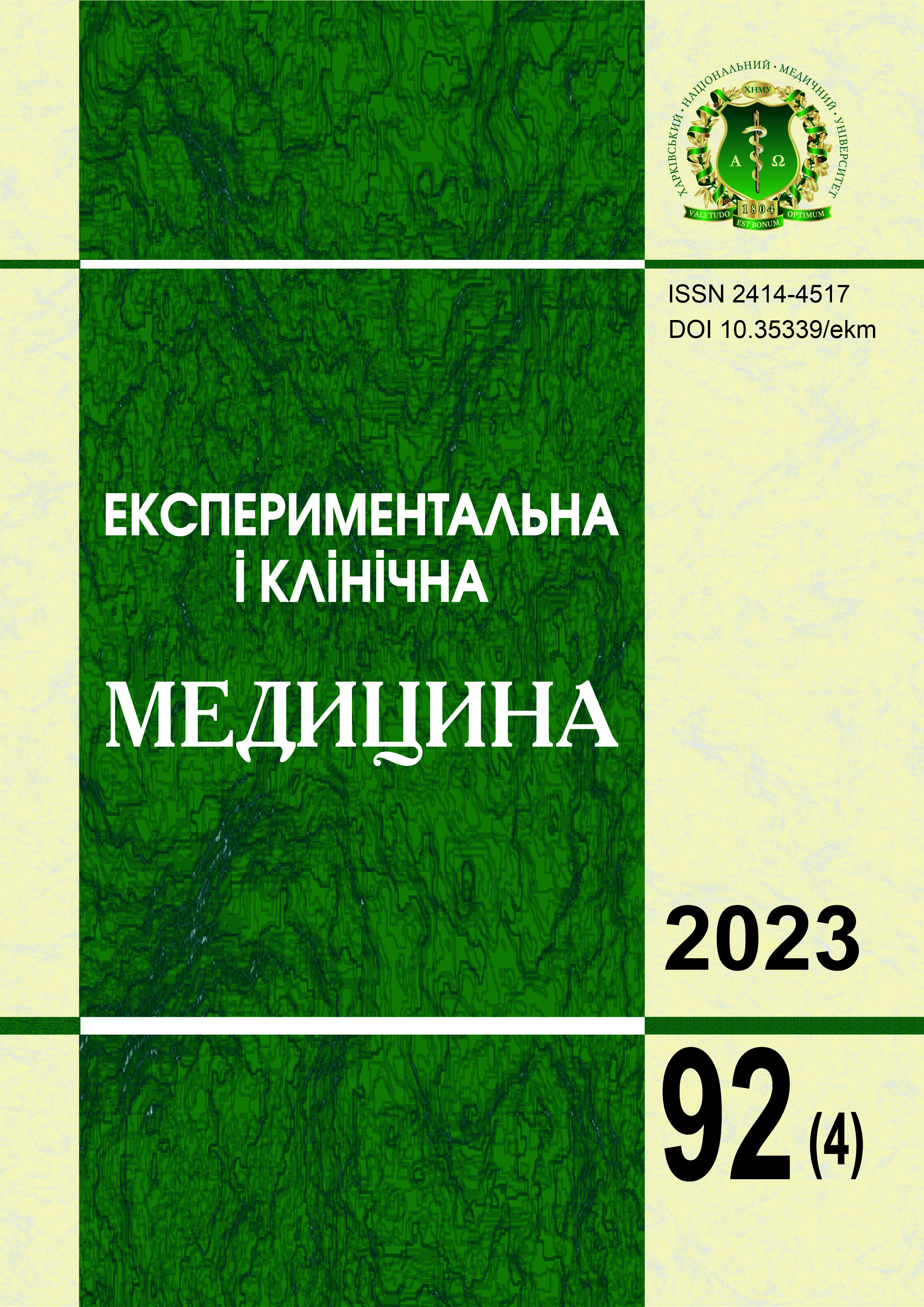Abstract
The microflora of the oral cavity affects not only the development and course of the pathology of the hard dental tissues but also the effectiveness of its treatment and prevention. Therefore, it is equally important for a dentist to determine the species composition of microorganisms and their quantitative characteristics. The aim of the work was to study the quantitative composition of the planktonic form of the dental biofilm of the vestibular surface of the cervical teeth in young patients; its analysis in patients with a wedge-shaped defect, cervical caries and clinically intact teeth. A microbiological study of the dental biofilm of intact premolars of 33 caries-resistant patients (average age [23.90±5.34] years) was conducted. All patients were divided into three groups depending on the condition of the hard dental tissues. The dental biofilm removed from the lesion was additionally examined in patients with wedge-shaped defects. Microorganisms were identified by morphological, tinctorial and biochemical characteristics. A quantitative study of the population level was carried out by counting colony-forming units (CFU) in one gram of biomaterial which was expressed as a decimal logarithm (lg CFU/g). An imbalance between representatives of pathological and normal microflora was determined. Patients with cervical caries had a significantly higher chance of having Str. mutans and Lactobacterium in the dental biofilm, and a lower chance Str. γ-haemolyticus (p<0.05). It confirms the role of Str. mutans and Lactobacterium in the etiology of cervical dental caries. There were no significant differences between the quantitative composition of the dental biofilm of patients of different groups that is probably related to the study of its planktonic component, the criteria for forming groups and the high level of caries resistance of the examined enamel. The obtained results can be useful in prescribing treatment and preventive measures for patients with cervical pathology of the teeth as well as in evaluating their effectiveness. In our opinion, it will contribute to a significant reduction in its prevalence and intensity among young people.
Keywords: microorganisms, оral cavity, wedge-shaped defect, cervical caries.
References
Rozhko VI, Luchynskiy MA, Petruniv VB, Piasetska LV, Rozhko OV. Microbiological spectrum of dental plaque in children with gastrointestinal tract diseases. Bulletin of Dentistry. 2021;40(2):74-7. DOI: 10.35220/2078-8916-2021-40-2.14. [In Ukrainian].
Skibitska O. Features local antibiotic therapy in patients with erosive and ulcerative lesions of the oral mucosa of various etiologies. Actual Dentistry. 2016;4:24-27. Available at: http://nbuv.gov.ua/UJRN/ss_2016_4_7 [in Ukrainian].
Nedashkivska VV, Dronova ML, Vrynchanu NO. Biofilms and their role in infectious diseases. Ukrainian Scientific Medical Youth Journal. 2016;4(98):10-9. Available at: http://surl.li/sjyoq [in Ukrainian].
Petrushanko TA, Chereda VV, Loban GA. Densiny of microbial colonization of young people oral cavity depending on the caries intensity. Word of medicine and biology. 2013;4:49-52. Available at: http://nbuv.gov.ua/UJRN/S_med_2013_4%2841%29__14 [in Ukrainian].
Savychuk NO. Kolonizatsiyna rezystentnist porozhnyny rota [Colonization resistance of the oral cavity]. Ukrainian Medical Journal. 2012;4(90):57-63. Available at: http://nbuv.gov.ua/UJRN/UMCh_2012_4_17 [in Ukrainian].
Machogan VR. Oral Microflora and its Role in the Pathogenesis of Generalized Periodontitis. Bulletin of problems in bioigy and medicine. 2014;4(4):25-9. Available at: http://nbuv.gov.ua/UJRN/Vpbm_2014_4%284%29__6 [in Ukrainian].
Petrushanko TA, Chereda VV, Loban GA. Qualitative composition of oral microbiocenosis in young adults who have dental caries of different intensity. Actual problems of modern medicine: Bulletin of Ukrainian Medical Stomatological Academy. 2013;13(2):50-2. Available at: http://nbuv.gov.ua/UJRN/apsm_2013_13_2_17 [in Ukrainian].
Divnych TY. Correction of changes of the oral cavitys microflora depends upon the duration of removable dentures use. Ukrainian Dental Almanac. 2015;4:47-9. Available at: http://nbuv.gov.ua/UJRN/Usa_2015_4_12 [in Ukrainian].
Klenovska SV, Schnaider SA, Maslov OV. Peculiarities of oral cavity microbiota changes in diabetes mellitus patients. Bulletin of Dentistry. 2019;107(2):29-33. DOI: 10.35220/2078-8916-2019-32-2-29-33. [In Ukrainian].
Chereda VV. Biophysical characteristics of oral fluid and microbial load of gingival sulcus under emotional. Actual problems of modern medicine: Bulletin of Ukrainian Medical Stomatological Academy. 2015;15(4):28-31. Available at: http://nbuv.gov.ua/UJRN/apsm_2015_15_4_7 [in Ukrainian].
Sidashenko OI, Voronkova OS, Sirokvasha EA, Vinnikov AI. Biofilm as a Spesial Form of Bacteria and its Role in Infectious Processes. Bulletin of problems in bioigy and medicine. 2013;3(2):36-41. Available at: http://nbuv.gov.ua/UJRN/Vpbm_2013_3%282%29__9 [in Ukrainian].
Kaskova LF, Amosova LI, Karpenko OO. Profilaktyka stomatolohichnykh zakhvoryuvan [Prevention of dental diseases]: textbook. Kharkiv: Fact; 2011. 392 р. Available at: http://repository.pdmu.edu.ua/handle/123456789/5758 [in Ukrainian].
Zabolotna II. Comparative analysis of the species composition of dental biofilm depending on the state of the hard dental tissues. Innovation in stomatology. 2023;3:65-72. DOI: 10.35220/2523-420X/2023.3.9. [In Ukrainian].
Ogorenko VV, Shornikov AV. Henderno-vikovi ta sotsialno-demohrafichni chynnyky ryzyku rozvytku nepsykhotychnykh psykhichnykh rozladiv v osib z aseptychnym nekrozom holovky stehnovoyi kistky [Gender, age and socio-demographic risk factors for the development of non-psychotic mental disorders in persons with aseptic necrosis of the femoral head]. Neyrone. 2023;1-2(138):28-30. Available at: https://neuronews.com.ua/uploads/issues/2023/1-2(138)/nn23_1-2_28-30.pdf [in Ukrainian].
Kryvko YuYa, Korniychuk OP, Fedorovych UM. Mikrobiolohiya z osnovamy imunolohiyi ta tekhnikoyu mikrobiolohichnykh doslidzhen [Microbiology with the basics of immunology and the technique of microbiological research: an electronic manual]. electronic textbook. Lviv; 2021. 540 р. Available at: https://lma.edu.ua/wp-content/uploads/2021/06/mikrobiologiya-z-osnovamy-imunologiyi-ta-tehnikoyu-mikrobiologichnyh-doslidzhen.pdf [in Ukrainian].
Kostenko О, Krivtsova М, Kostenko Е, Savchuk О. Analysis of the dominant microbial associations of the cavity of the mouth and especially their sensitivity to antibacterial drugs. Actual dentistry. 2018;5:40-3. Available at: https://www.dentalexpert.com.ua/journal/modern_stomatology/2018/SS_01_2018/SS_01_2018/assets/common/downloads/SS01_2018_SS2013.pdf [in Ukrainian].
Sydorchuk LI, Mikhieiev AO, Blinder ОО, Sydorchuk IY. Oral microbiome of early working age people (15–24 years old), suffering from chronic catarrhal gingivitis on the background of newly diagnosed type 1 diabetes. Bulletin of Dentistry. 2022;121(4):99-105. DOI: 10.35220/2078-8916-2022-46-4.17. [In Ukrainian].
Tereshina TP, Zahradska OL. Oral microbial balance in young adults with multiple caries. Innovation in stomatology. 2022;1:64-7. DOI: 10.35220/2523-420X/2022.1.10. [In Ukrainian].
Nikulina YY, Voronkova OS, Dzhepa TV, Polishko TM, Vinnikov AI. Antimicrobial Resistance and Biofilm Formation of Clinical Isolates Candida Spp. Bulletin of problems in bioigy and medicine. 2013;3(2):263-7. Available at: http://nbuv.gov.ua/UJRN/Vpbm_2013_3%282%29__57 [in Ukrainian].

This work is licensed under a Creative Commons Attribution-NonCommercial-ShareAlike 4.0 International License.

